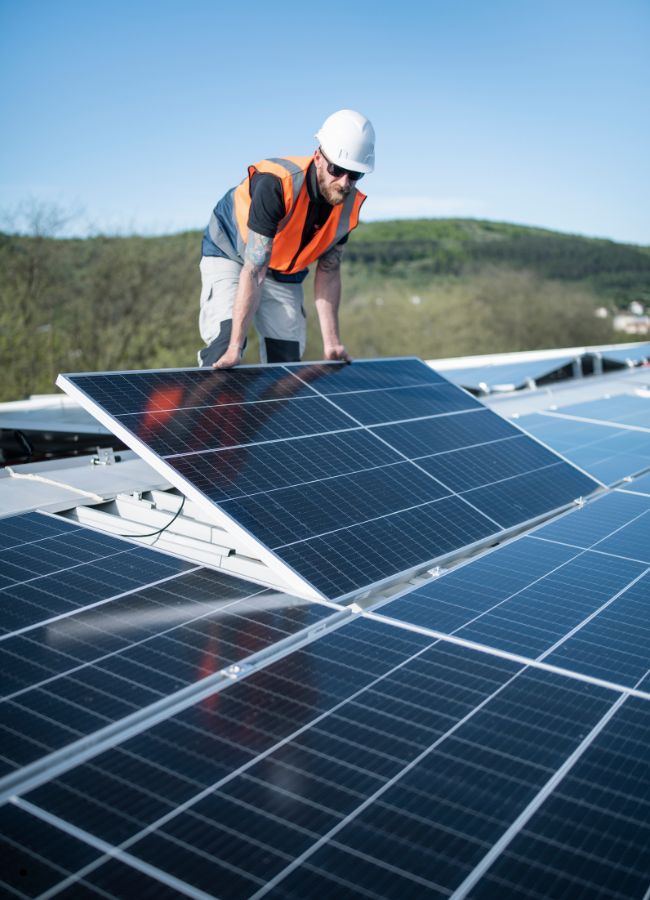As the world continues its shift towards renewable energy, bifacial solar panels are emerging as a game-changing technology in the solar power industry. Unlike traditional solar panels that capture sunlight from one side, bifacial panels(double-sided solar panels) are designed to harness solar energy from both their front and back surfaces, significantly increasing their efficiency and energy output.
This unique capability allows them to capture reflected light from surfaces like the ground, snow, or even water, making them an ideal solution for locations where maximizing
energy production is essential. In this blog, we’ll explore how bifacial solar panels work, their benefits, potential applications, and what they mean for the future of clean, sustainable energy.
What Are The Bifacial Solar Panels?
Solar panels, or monofacial panels, are solar cells that convert sunlight into energy. Traditional panels use only one side, absorbing light from the front and back. Bifacial panels have solar cells on
both sides, absorb light from both sides and capture light reflected off the ground, resulting in more electricity production.
Bifacial solar panels capture light energy on both sides, unlike traditional monofacial panels, which only absorb sunlight on the front. They’re not suitable for rooftop installations but work well with residential ground-mounted systems. Ideal for commercial and utility-scale installations, they’re more expensive due to additional equipment.
How Are Bifacial Solar Panels Modules Installed?
Bifacial modules are installed differently based on their type, with framed modules being easier to install and frameless models having rubber guards to protect the glass. Higher tilting increases
power output, making them better for flat commercial rooftops and ground-mounted arrays. The mounting system can affect the performance of bifacial modules, with racking systems with support rails shading back rows of cells.
Junction boxes on bifacial panels can be smaller or separated to prevent shading. Mounting and racking systems specifically designed for bifacial installations eliminate the issue of backside shading.

Advantages Of Bifacial Solar Panels
Enhanced Generation Of Solar Energy
Bifacial solar panels offer buyers a 30% increase in solar power production per installed panel, with the increase largely influenced by the design of the solar panel array.
Increased Durability
Bifacial technology is often used with a ‘dual-glass’ construction, consisting of a 3.2mm glass sheet on the front and an opaque polymer back sheet underneath. This design offers greater durability,
as seen in Australian bifacial solar panels with longer performance warranties and slower cell degradation rates.
The Best Bifacial Solar Supplier In Australia?
Some Of The Reputed Bifacial Solar Suppliers In Australia:
Jinko Solar
Jinko Solar, an Australian top solar panel brand, won the 2019 Intersolar Award for its Swan Bifacial Module and has a history of awards.
Phono Solar Australia /strong>
Phono Solar Australia, a solar panel supplier, offers Diamond Dual Glass panels with bifacial technology, allowing for power absorption from both sides.
Renogy
Renogy, a solar panel supplier, offers bifacial panels that can increase energy output by up to 30% compared to traditional panels, making them suitable for RVs, rooftops, and cabins.
How Much Do Bifacial Solar Panels Cost In Australia?
In Australia, bifacial solar panels cost around $1.80 per watt, slightly more than monofacial panels. The cost of installing solar panels varies depending on the system size, with 4 kW systems costing around $4,000, 6.6 kW systems between $5,000 and $9,000, 10 kW systems between $9,500 and $12,000, and 13 kW systems between $10,000 and $18,000.
Payback Of Bifacial Solar Panels Cost In Australia
Australia offers solar rebate programs to reduce the upfront cost of solar panel installation, often offered by federal and state governments. These programs aim to promote renewable energy adoption by making solar systems more accessible to a wider range of people.
Government Policy Of Bifacial Solar Panels
The Australian government provides various incentives and rebates to encourage solar energy adoption, with additional state and territory governments offering additional incentives and feed-in tariffs. Understanding these incentives can significantly reduce solar panel system costs, such as the Inflation Reduction Act.
Regulatory Changes
The Inflation Reduction Act may alter solar industry regulations, potentially affecting standards, safety requirements, and import tariffs, potentially affecting the overall cost structure.
Investment In Research
The government may allocate funds for clean energy research and development to promote economic stability and innovation, thereby enhancing the cost-effectiveness of solar options.
In Conclusion:
In conclusion, Bifacial solar panels significantly advance renewable energy technology, offering improved efficiency, versatility, and greater energy output. A PV module bifacial generates electricity from both sides due to a similar metal grid and captures light from over 95% of its surface area. Despite careful planning, their long-term gains in energy yield and cost-effectiveness make them an attractive investment for sustainable power. As clean energy demand grows, bifacial technology will play an important role in achieving a greener, more efficient energy landscape.



